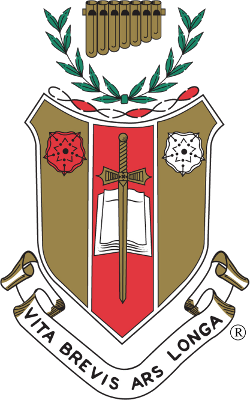
The Integrated Taxonomic Information System (ITIS) is an American partnership of federal agencies designed to provide consistent and reliable information on the taxonomy of biological species. ITIS was originally formed in 1996 as an interagency group within the US federal government, involving several US federal agencies, and has now become an international body, with Canadian and Mexican government agencies participating. The database draws from a large community of taxonomic experts. Primary content staff are housed at the Smithsonian National Museum of Natural History and IT services are provided by a US Geological Survey facility in Denver. The primary focus of ITIS is North American species, but many biological groups exist worldwide and ITIS collaborates with other agencies to increase its global coverage.

Kappa Alpha Theta (ΚΑΘ), commonly referred to simply as Theta, is an international women’s fraternity founded on January 27, 1870, at DePauw University in Greencastle, Indiana. It was the first Greek-letter fraternity established for women. The fraternity was founded by four female students, Bettie Locke Hamilton, Alice Allen Brant, Bettie Tipton Lindsey, and Hannah Fitch Shaw. The organization has 147 chapters at colleges and universities in the United States and Canada. The organization was the first women's fraternity to establish a chapter in Canada. Theta's total living initiated membership, as of 2020, was more than 250,000. There are more than 200 alumnae chapters and circles worldwide.

Vertigo Records is a British record company. It was a subsidiary of the Philips/Phonogram record label, launched in 1969 to specialise in progressive rock and other non-mainstream musical styles. Today, it is operated by Universal Music Germany, and the UK catalogue was folded into Mercury Records, which was absorbed in 2013 by Virgin EMI Records, which returned to the EMI Records name in June 2020.

Southwestern University is a private liberal arts college in Georgetown, Texas. Formed in 1873 from a revival of collegiate charters granted in 1840, Southwestern is the oldest college or university in Texas. Southwestern offers 40 bachelor's degrees in the arts, sciences, fine arts, and music as well as interdisciplinary and pre-professional programs. It is accredited by the Southern Association of Colleges and Schools and the National Association of Schools of Music and historically affiliated with the United Methodist Church.

Texas A&M University–Texarkana (A&M–Texarkana) is a public university in Texarkana, Texas. It is part of the Texas A&M University System.

Gamma Phi Beta is an international college sorority. It was founded in Syracuse University in 1874 and was the first of the Greek organizations to call itself a sorority. The term "sorority" was coined for Gamma Phi Beta by Dr. Frank Smalley, a professor at Syracuse University.

Phi Mu (ΦΜ) is the second oldest female fraternal organization established in the United States.

Zeta Phi Beta Sorority, Inc. (ΖΦΒ) is a historically African American sorority. In 1920, five women from Howard University envisioned a sorority that would raise the consciousness of their people, encourage the highest standards of scholastic achievement, and foster a greater sense of unity among its members. These women believed that sorority elitism and socializing overshadowed the real mission for progressive organizations. Since its founding Zeta Phi Beta has historically focused on addressing social causes.

Tau Beta Sigma Honorary Band Sorority, is a co-educational service sorority.
The National Beta Club is an organization for 4th through 12th grade students in the United States. Its purpose is "to promote the ideals of academic achievement, character, leadership and service among elementary and secondary school students.". Headquartered in Spartanburg, South Carolina, the organization has more than 8,750 clubs nationally and internationally.
While the traditional social fraternity is a well-established mainstay across the United States at institutions of higher learning, alternatives – in the form of social fraternities that require doctrinal and behavioral conformity to the Christian faith – developed in the early 20th century. They continue to grow in size and popularity.
Cultural interest fraternities and sororities, in the North American student fraternity and sorority system, refer to general, social organizations oriented to students having a special interest in a culture or cultural identity.

Sigma Alpha Iota (ΣΑΙ) is an international music fraternity. Formed to "uphold the highest standards of music" and "to further the development of music in America and throughout the world", it continues to provide musical and educational resources to its members and the general public. Sigma Alpha Iota operates its own national philanthropy, Sigma Alpha Iota Philanthropies, Inc. Sigma Alpha Iota is a member of the National Interfraternity Music Council and the Professional Fraternity Association.
Settlement schools are social reform institutions established in rural Appalachia in the early 20th century with the purpose of educating mountain children and improving their isolated rural communities.
Texana denotes both the history and culture of Texas. It may also refer to:
The expansion of Greek letter organizations into Canada was an important stage of the North American fraternity movement, beginning in 1879 with the establishment of a chapter of Zeta Psi at the University of Toronto. In 1883, the same fraternity established a chapter at McGill University. Other early foundations were Kappa Alpha Society at Toronto in 1892 and at McGill in 1899, and Alpha Delta Phi at Toronto in 1893 and at McGill in 1897. The first sorority, Kappa Alpha Theta, was established in Toronto in 1887. In 1902, the first international chapter of Phi Delta Theta was established at McGill University as the Quebec Alpha.

Chionothrix is a genus of plants in the amaranth family, Amaranthaceae and is found in Africa distributed in north-east tropical Africa.
Dasysphaera is a genus of plants in the amaranth family, Amaranthaceae and is found in Africa distributed in north-east and east tropical Africa.

Froelichia floridana is a species of flowering plant in the genus Froelichia, in the amaranth family (Amaranthaceae). It is known as prairie cottonweed, Florida snakecotton, large cottonweed, field snakecotton, or plains snakecotton. An annual, it produces white woolly flowers on tall flowering stalks, growing up to 40 in (1,000 mm) in height. The narrowly oblanceolate to elliptic leaves are opposite, occurring on the lower third of the stem. It grows in central and eastern North America, from the Great Plains to Mexico, east to the Atlantic Coast. Its propensity to spread easily has resulted in it being considered an agricultural weed and it is an invasive species in Australia.












